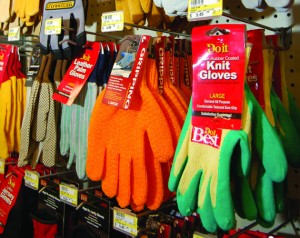To download a PDF of this story, click here, and visit hardwareretailing.com/retailing-101 to take a quiz and determine how much you know about marketing, operations, finances and human resources.
What Does Your Report Card Look Like?
By Liz Lichtenberger, llichtenberger@nrha.org and Kate Klein, kklein@nrha.org
When was the last time you reviewed your balance sheet or took another look at your advertising plan?
While you’re busy running the day-to-day side of your business, it’s always a good idea to take a step back and review some of the more strategic aspects of your operation.
When you finally carve out time to examine your business with a more strategic eye, you also have to make sure your business skills are up to snuff. You likely left school a long time ago, and poring over balance sheets or marketing plans might seem a little daunting.
The editors at Hardware Retailing want to help you out. In this story, we’ll offer some tips and information about four important parts of your business: marketing, finance, operations and human resources. While we won’t cover everything you might find in an MBA class, we’ll highlight a few basic principles that could help you and your business through a down-and-dirty strategic evaluation.
We’ll discuss how you can determine the best ways to reach your target audience and some promotions ideas you can try. We’ll also go over some basic financial documents and why they’re important to tracking sales, expenses and cash flow, and how these statements can help you better understand your growth opportunities.
In addition, we’ll cover important activities in your day-to-day operations and how to make sure you’re doing these as efficiently and successfully as possible. Finally, we’ll offer some training and management tips and tell you how to get all the information you need about hiring, firing, keeping track of benefits and other tasks that human resources duties might require.
While you perform these functions on a daily basis, many of you may feel you have room for improvement—take a look at the grades on the report card on the right. These are the averages of the results from a group of retailers who were asked to grade themselves in these areas.
So, what’s your report card look like? After you’ve read the story, find out by visiting hardwareretailing.com/retailing-101 and taking a quiz to determine how much you know about these four parts of your operation.
Marketing
Marketing includes understanding who your customers and competitors are, studying the local economy and marketplace and then reaching out to a targeted customer base by adapting your product mix and promotions and finding product or service niches that aren’t being offered in the market yet.
What You Need to Know:
To run your business effectively within your market, you need to do a few things.
- Know your market. Who are your customers? Who are your competitors? What is the economic climate? What is the housing market like? Market studies you do or hire outside companies to conduct, as well as census data and local housing statistics, would help you here.
- Set marketing goals, such as increasing sales by a certain percentage or reaching younger customers, and make a plan to get there. Are your goals specific and achievable? Check in a year and see if you’ve met these goals.
- Know your place in the market. What do your customers think of you? Where are there growth opportunities? A simple in-store survey completed by your customers could be a good way to find answers.
When Greenwood Hardware in Seattle set out to create a marketing plan, the store’s leaders understood that they needed to gain a better understanding of exactly who their customers were.
In 2012, they worked on one of the key planning steps for successful marketing—identifying their market, and then narrowing that market into specific segments.
Market research is the foundation for any successful marketing strategy, and that information can be collected a variety of ways, ranging from paper questionnaires that customers fill out while they’re in your store to in-depth studies that outside companies conduct.
Evaluating a store’s strengths and weaknesses, its competition and possible new business opportunities is also key to identifying which market segments to serve and what products to stock—all part of a successful marketing plan.
Customer Service and Community Presence
Greenwood Hardware’s target market is northern Seattle homeowners and renters, and the competition for these customers’ business is stiff, store general manager Willow Yoder says. Yoder felt she didn’t want to go head-to-head with big boxes on price, and she also knew many of the products stocked in her store could be found at other retailers.
But she is also keenly aware that her store’s strengths include personalized customer service and a carefully maintained local community presence, so staying strong in those areas is a priority, she says.
Community involvement, through sponsoring local art walks and kids’ sports teams, differentiates the store from its many competitors, such as Bed Bath & Beyond and Lowe’s.
“To stay a part of the community is the best way to stay relevant. There’s so much competition, and we can’t compete on price,” Yoder says. “We feel that’s our way to continue on in the hardware business.”
Focusing on serving a specific demographic has helped. Greenwood Hardware employees used a survey of existing customers to identify the store’s primary market segments so they could focus their product mix and promotions. Through the survey, they discovered that about 60 percent of the shoppers were women.
The store’s simple, in-house market study helped the retailer cater its product mix to the market segment most drawn to the store, and it also encouraged the retailer to target promotional efforts toward the female shopper. This survey has provided the basis for making successful marketing changes and keeping the retailer growing.
For example, Greenwood Hardware expanded its housewares department to appeal more to the majority female customer base, adding products and ensuring styles are on-trend. The store began selling kitchen composters and a line of stylish, colorful floor mats, and both have become hot sellers for the store, Yoder says.
When it came to measuring the impact their marketing and promotional programs were having on reaching their goals, tracking results was a bit more observational, as the Greenwood team relied on feedback from employees and their own impressions of how the customer mix was changing.
However, adapting the store product mix and experimenting with promotions such as in-store events and donations to charities appear to be working, because sales are increasing, Yoder says. Basket size at the store has increased by $5 on average over the past few years, she says.
Trying Something New
Another way the store capitalized on the results of its customer survey was by improving its promotions, including the launch of a profitable special event. The retailer hosted a ladies’ night, offering free wine and hors d’oeuvres, such as chocolates and nuts. In addition, the business brought in a female electrician and an organic fertilizer sales representative to answer customers’ questions during the event. The store also gave free goody bags to the first 50 women to arrive.
The event was a smashing success. About 200 women showed up, crowding into the 5,500-square-foot store for two hours of a weekday evening. Greenwood Hardware more than tripled its typical sales for those two weeknight hours, at a minimal cost to the business, Yoder says.
The store kept costs low for the ladies’ night by advertising the event for free in its e-newsletter and on social media sites such as Facebook, and spending most of the money for the event on food and wine. Staff stuffed goody bags for free using vendor samples, such as lip balm, gloves, sandpaper and hand soap—all items the store also sells.
The event has brought in new, loyal customers, and proved to be a promotional tool Yoder expects the store to repeat once or twice per year, she says.

Like the ladies’ night promotion, marketing efforts should be directed at specific market segments. Market research can help you identify who your current loyal shoppers are and what the demographics of your community are. You can use the data to take steps that help your business keep its customers, attract new shoppers and compete with other stores. Those efforts could mean changing your prices and advertising or adding and eliminating products, based on what you learn.
For Greenwood Hardware, market research, new promotional strategies and catering the product mix to a specific market segment have helped drive sales, Yoder says. Sales have been on the upswing since 2002 despite the recession, with an increase of 14 percent between 2007 and 2012, she says.
Like Greenwood Hardware, you need a marketing strategy to keep your customers from drifting to big-box stores or other competitors.
Finance
How companies handle and use large amounts of money. Companies track finances using various financial documents, such as balance sheets, income statements and cash flow statements, which allow owners to see how much money a company has at any given time, compare revenues and expenses and keep track of cash on hand.
What You Need to Know:
Here are a few things to focus on as you look at your finances.
- A balance sheet provides a company’s financial position at a given point in time.
- An income statement presents revenue derived from the sale of merchandise and also shows expenses incurred.
- A cash flow statement shows how changes in the balance sheet and income statement affect the amount of cash you have on hand and how it flows in and out of your business.
As a business owner, you have plenty of financial documents to pore over as you look at the strength of your business— sales, profits, margins and more. We’re going to focus on three of the most common financial statements that any business should have on hand: balance sheets, income statements and cash flow statements.
Of course, you can’t just look at this information in a vacuum—instead, you need to compare it to other standards, such as the North American Retail Hardware Association’s (NRHA) annual Cost of Doing Business study, which is published annually and provides information about the financial performance of the home improvement industry.
Balance Sheets
A balance sheet is a way to see your company’s financial position at any point in time. It’s best described as assets equals liabilities plus shareholders’ equity.
Assets are anything a company owns that has value. Liabilities are the amounts a company owes to anyone else. Shareholders’ equity is what would be left over if a company sold off its assets and paid off its liabilities.
So what other information can you find on your balance sheet?
“I focus heavily on accounts payable, or current liability; various short-term debt levels, like lines of credit; and additions to fixtures and equipment,” says T.J. Comstock, owner of Billings Hardware in Montana. “Most of these are current liabilities or current assets. Typically, things that are defined as long-term have set payment schedules or useful lives so you can anticipate where they are going and are more valuable to look at on a quarterly, semi-annual or annual basis.”
You can measure your ability to pay off debts—both short-term and longer-term—with the current ratio (current assets divided by current liabilities) or compare your debt-to-equity ratio (total liabilities divided by net worth; $1 of debt to $1 of equity is usually considered practical). This ratio, for example, may tell you how efficiently your business is operating. With some information from your income statement, you can also calculate your return on assets (profit margin multiplied by asset turnover).
You can also see what your current assets (such as cash, inventory and accounts receivable) and non-current assets (buildings, land and machinery) include, or look at your liabilities and see what you owe, both long-term and shortterm. Current liabilities are those you need to pay within the next 12 months, while long-term liabilities are not due for more than a year.
If your balance sheet shows that you have excess cash, there are, of course, many different ways you can use that money. You may be able to increase your advertising budget or invest in a new POS system. Or it may be time to hire an additional employee or two. Keeping a close eye on your balance sheet and knowing how to read it ensures you know where you stand financially and if you have the money you need to pay for any improvements you might like to make.
Income Statements
An income statement shows how much revenue your company earned during a specific period of time. To put together your income statement, start with the amount of sales during a certain period, then subtract your expenses, one by one. When you’ve finished, the number you’re left with is your net profit (if you had more in sales than expenses) or net loss (if you had more in expenses than sales).

“I primarily use the income statement to track operating expenses,” Comstock says. “The largest item is labor expense, or salary, and I typically follow it as a percentage of total income. This provides a good benchmark against stores of different size and the industry as a whole. The second operating expense I pay a lot of attention to is advertising.”
He says he focuses on these two expenses because they are some of his largest expenses and because they are variable expenses.
“Occupancy is also a very large item, but it is a fixed expense and is more or less known month to month,” Comstock says. “Other things that I like to look at on the income statement are store supplies, travel expenses and anything else that shows a large increase or decrease for that month relative to the prior year’s numbers.”
An income statement provides you with plenty of information about your business and its financial strength, including gross margin (calculated as net sales minus cost of goods sold), profit margin (income minus expenses), sales per employee (net sales divided by full-timeequivalent employee counts) and more. It also tells you your operating expenses (including general and administrative expenses) and your operating income (which you can find by subtracting your operating expenses from your gross profit).
Your POS system is an invaluable tool as you track the numbers on your income statement. “Single stores or stores with a multi-store platform POS will look to that system for sales, cost of goods sold and gross profit information,” Comstock says. “The same can be said for inventory and accounts receivable information from the balance sheet.”
Knowing your operating income helps determine your measure of profitability.
Again, for many of these numbers, it’s helpful to compare to the industry standard. To do so, take a look at NRHA’s annual Cost of Doing Business study. To get your copy, visit www.nrha.org.
Cash Flow Statement
A cash flow statement shows changes to the amount of cash a company has on hand.
“While basically a recap of the balance sheet and income statement, it is a valuable document to review, as it gives a very quick snapshot of where your cash came from and went,” Comstock says. “I would argue that it is the least understood and possibly the most important of the three financial documents, as some people might see net income and think that they have money, not realizing that net income does not equal cash flow.”
Net income can be reduced by debt repayment or inventory or accounts receivable growth, or it can increase with increases in financing or accounts payable.
“Any item on the cash flow statement can be found on the other two documents, but unless they are very obvious, or someone is very good at understanding the relationships, the cash flow statement provides a great and faster insight to a business’s performance,” Comstock says.
Operations
Activities involved in the day-to-day functions of the business conducted for the purpose of generating profits. These activities include, but are not limited to, overseeing how much you invest in merchandise, organizing and making store displays attractive and keeping operational expenses down.
What You Need to Know:
Keep the following in mind as you look at your operations.
- Common operations functions include inventory management, merchandising and expense control, and you should use these different functions together to have the most successful business.
- Inventory management means making sure you are investing the right amount of money in your inventory selection—enough to have everything your customers need, but not so much that you have product sitting on the shelves for too long.
- Merchandising is a way to make your store more organized and attractive to customers, making them want to shop there and helping them easily find what they need when they go in the door.
- Expense control involves finding ways to keep expenses down, so you aren’t spending too much on the day-to-day operations (which can take away from your bottom line).
As a retailer, it’s important to find a balance between looking at the day-to-day activities in your business and looking at the big picture. The day-to-day tasks alone can take up plenty of time. Do you have the proper amount of inventory in your store? Are you using your POS system in the most efficient way you can? Could your store be better merchandised? Are you doing everything you can to keep your expenses under control?
In this section, we’ll explore three key parts of your operations: inventory management, merchandising and expense control.
Inventory Management
Inventory is a tricky thing. If you have too much, your money’s tied up in the products on your shelves. But if you don’t have enough, you’re missing out on potential sales or creating a negative customer interaction with stockouts.

“Inventory is one of those areas where you strive for perfection in order to get close,” says Doug Carroll, manager of Brownsboro Hardware & Paint in Louisville, Kentucky.
Caroll says the main priority for him and his staff is to have items in stock, no matter the time of year. “No one buys box fans in the winter, but we want to have at least a few on the shelves this time of year, just in case,” he says. “It’s a sacrifice, but it’s worth it to keep the shelves full for our customers.”
What we are going to focus on are a few numbers that can help you determine if your investment in inventory is paying off for you.
First, measure your inventory per square foot, which is calculated as inventory divided by square feet of selling area. Compare it to the numbers from NRHA’s 2014 Cost of Doing Business study to see if your inventory per square foot is higher or lower than the average. If it’s higher, make sure you’re regularly removing dead and slow-moving items.
If your inventory per square foot is lower than average, take a look around your store and see how many shelves or peg hooks are empty. Think about how often customers request certain items you don’t have. Pick a category or two to focus on and determine which products you want to add to your inventory.
Also take a look at your inventory turns (cost of goods sold divided by inventory), which shows how quickly you go through particular products. As with inventory per square foot, low turnover means products may be sitting too long on the shelves, tying up dollars that could be better used elsewhere.
To make sure you are putting the right amount of money toward inventory, keep an eye on your gross margin return on inventory (GMROI), which is calculated as gross margin divided by inventory times 100. This is a good way to tell if you’re spending too much or too little on the inventory in your store.
Make sure you utilize the features of your store’s POS system. Like many retailers, Carroll uses the POS system in his store to track inventory (and, twice a year, two employees at each store are dedicated to doing cycle counting, just to make sure quantities are correct).
But one of Carroll’s goals is to try to get more out of the POS system. For example, he’s currently trying a new program from his system that will help him better track any drop-ship orders or orders from a different wholesaler than his primary one.
“You pay so much for this POS system, and then you wonder what percent you’re actually using,” he says. “We want to use it to make sure we’re managing our inventory the best that we can and that we’re getting our money’s worth with the system.”
He and his staff still have some challenges, such as a higher margin of error with counting SKUs that transfer between the business’s two locations. He also reminds his cashiers to scan every single item in a purchase. “You may see four light bulbs and think they’re all the same, so you scan one and change the quantity to four,” he says. “But if they’re different, you may have lost money on that transaction, and now your inventory is off, too.”
Merchandising
Merchandising includes anything you do in your store to display and promote merchandise to your shoppers. But it’s much more than putting products on shelves. Here are a few tips to follow as you create a merchandising plan for your store:
• Display labels clearly. Customers should be able to see what the product is and what it costs with just a quick glance at a display or endcap. If they have to search too much for this information, they may just pass the display by.
• Keep shelves fully stocked. Make sure there are no spaces or gaps in displays where product should be. Keeping shelves stocked makes them appear more attractive and reminds customers you can offer them whatever they’re looking for.
• Try creative displays. Putting together how-to displays gives customers the step-by-step information they need. And working displays, which show a product in use, help customers picture themselves using the product, which makes them think that much more about buying that product.
• Use color. Adding color to your displays makes them bright and attractive. Also make sure the displays are neatly and logically arranged. For example, if you have a product that comes in several different sizes, try arranging it by size so customers can see the full variety of sizes offered.
• Use effective signage. Exterior signage should tell customers what kind of store yours is and give them a good idea of what products you offer. Interior signage should help them easily find where each department is located in your store. If you have blank wall space, hang signage provided by your distributor or one of your vendors.
• Use merchandising to help with suggestive selling. If you have a product you’re eager to get rid of, put together an endcap or dump bin for that product. Add colorful signage—a clearance sign is a great way to draw your customers’ attention—and even a printout or display with additional product information to make customers more likely to check out the display and buy that particular product. Carroll says his business has a half-off table where he and his staff continually add slow-moving product. People are always digging through to see what they can find.
• Think about where products go. Place particular products you want to promote near the front of the store or in the power aisle.
Expense Control
The first step for expense control is to identify what your expenses are. Next, evaluate if they are reasonable. Controlling expenses is all about managing expenses and reducing them if necessary.
So how do you do this? The key to controlling expenses is looking closely at what those expenses are and seeing where you can cut. Take a close look at your income statement and think about where you might be able to make changes.
For example, a lot of advertising can be done inexpensively, or even for free, through social media. Managing your inventory well, as discussed above, can free up some dollars, too.
Don’t forget other less retail-focused things like utilities and office supplies. You may be able to cut back on the electric bill by installing LED lighting or make an effort to save on printing or find ways to save on postage and shipping. Looking around and finding ways to make these cuts can all add up in decreasing your expenses.
And keep the bigger expenses in mind, like rent. Maybe you’ll find yourself in a financial position where you might want to consider buying a building. Also consider employee salaries and schedules. Are you paying your workers a fair wage? Is anyone making too much or too little? Do you have any shifts where you’re overstaffed? The money saved by cutting even a few hours for a few workers can add up.
Human Resources
Responsibilities within a business for dealing with the people who work for that organization. Human resources duties may include hiring, firing, company-wide training, interviewing and handling paperwork for performance reviews, insurance and other benefits and more.
What You Need to Know:
To manage your human resources functions as effectively as possible, remember the following.
- Human resources encompasses hiring, firing, training, paying, protecting and insuring your employees, as well as offering benefits packages that can include retirement accounts and personal days.
- Each state has its own labor laws. Visit the U.S. Department of Labor website, www.dol.gov, or the website for Canada’s Labour Program, www.labour.gc.ca, for guidance on finding rules specific to your state or province.
- Depending on the size of the operation, many U.S. businesses are now required to offer health insurance to employees. Canadian companies don’t have to offer medical insurance because healthcare is free in the country. Still, Canadian businesses can offer optional insurance benefits, such as vision and dental.
Dealing with the people who work for your business has myriad implications and rules. The state and federal governments manage most of those processes with plentiful laws, and some of those laws vary by state.
The laws include prohibiting discrimination against employees based on age, race, religion, gender or disability when hiring; protecting employees from workplace sexual harassment; and establishing minimum wage.
Some states are heavily unionized, and firing underperforming workers who are labor union members is a lengthy process. In right-to-work states such as Arkansas and Indiana, where a company can’t sign a contract requiring workers to be union members, a business owner could fire a nonunion employee for any reason at any time.
But what likely impacts your day-to-day business far more often is the productivity of employees and how well they are trained.
The interpersonal relationships in employee management depend on managers’ personalities, leadership styles and communication skills—and those less tangible variables can help or harm your workers’ productivity. Those human resources issues can be sensitive to measure and difficult to change.
“[E]ven a small number of actively disengaged workers can have an outsized impact on overall productivity,” according to an article by Dan Enthoven for Inc. “Employers need to find the right balance to maintain effective oversight without killing their culture and driving away their best employees.”
A New Training Program
You shouldn’t closely monitor workers for policy breaking as much as you should emphasize improving efficiency and getting employees on board with evaluating their own work and making changes—such as adding more training or adjusting behaviors, the Inc. article recommends. Dwayne Gibson and other managers at Picton Home Hardware Centre in Ontario, Canada, have seen this firsthand.
The managers assumed employees would simply learn their responsibilities on the job, but when Picton offered non-mandatory formal training in 2013, all of their workers wanted to participate, Gibson says.
The workers wanted to be better educated on the products they sell and understand the company’s expectations for them, so they embraced the training, he says.
“They appreciate it,” he says.
The workers have now done NRHA online training, watched webinars related to new products and passed tests on the topics they studied. The business will offer online training every year now, and can adapt the class topics to the particular skill level of each employee, Gibson says.
Because of the training, employees have grown in confidence with assisting customers. The less experienced workers aren’t as afraid to talk to shoppers now that they understand the store’s products better and know what their managers expect of them, he says.
In 2013, Gibson also started doing more handson work alongside his employees to understand why new workers weren’t as productive as he knew they should’ve been.
He hadn’t realized that management style and lack of attention to training were impacting performance. He knew he struggled to get new workers trained efficiently. The employees made mistakes, had to repeat tasks because of those errors and didn’t often go to Gibson with questions about how to improve their work.
Managing More Effectively
Gibson learned through an NRHA management class that he wasn’t communicating expectations to new employees or working alongside them until they understood how to accomplish work correctly. Managers would quickly demonstrate or complete a task for lagging employees, but wouldn’t stay to ensure the workers could do it themselves. Gibson changed that.
“I help them more. I get in there shoulder to shoulder with them more than I used to,” he says.
The company doesn’t have formal ways to evaluate employee productivity, but Gibson does watch to see if workers need more training on tasks such as ordering products or helping customers return items. “You can tell by watching if someone is 100 percent able or needs a little more training,” he says.
The workers seem to respect him more due to the relationships that have resulted naturally from working together more closely and, as a result, they approach him more often with questions about how they can improve their work, Gibson says.
“Respect can be a simple but powerful motivator… When employees feel genuinely respected (always assuming it’s warranted), they’re much more likely ‘to go the extra mile’ to help a company succeed,” Victor Lipman writes in an article for Forbes.
Picton Home Hardware workers now make fewer mistakes and work more efficiently because they understand how to do their jobs better. And they take more ownership of their work, volunteering to help instead of just doing the minimum to get their jobs done each day, Gibson says.

Managers needed to learn how to communicate and train effectively, just as workers needed to learn to do their jobs well, Gibson says.
Gibson also got frustrated with the complaints employees made about others on his team. He occasionally lost his cool when workers brought up problems he saw as petty. For example, if a cashier complained that another worker wasn’t coming promptly when called or was chatting too long with customers rather than answering phones, he sometimes got angry.
Gibson realized he was making himself unapproachable when he got upset about workers’ complaints without hearing their full stories, instead of converting problems into training opportunities.
He now sits down with employees, listens and writes out their concerns. If the complaint is petty, he asks the workers what they think should be done to resolve the problem. He believes he’s learned a more respectful way to communicate with workers, helped them learn to handle their own concerns and improved morale. He’s also helped other managers get on board with the more respectful management style.
“They’re not just there to do the job,” he says. “You don’t necessarily have to like each other, but you have to get along.”
 Hardware Retailing The Industry's Source for Insights and Information
Hardware Retailing The Industry's Source for Insights and Information








